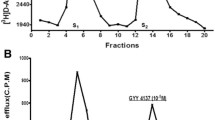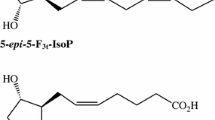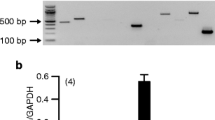Abstract
Hydrogen sulfide (H2S) has been reported to exert pharmacological effects on neural and non-neural tissues from several mammalian species. In the present study, we examined the role of the intracellular messenger, cyclic AMP in retinal response to H2S donors, sodium hydrosulfide (NaHS) and sodium sulfide (Na2S) in cows and pigs. Isolated bovine and porcine neural retinae were incubated in oxygenated Krebs buffer solution prior to exposure to varying concentrations of NaHS, Na2S or the diterpene activator of adenylate cyclase, forskolin. After incubation at different time intervals, tissue homogenates were prepared for cyclic AMP assay using a well established methodology. In isolated bovine and porcine retinae, the combination of both phosphodiesterase inhibitor, IBMX (2 mM) and forskolin (10 μM) produced a synergistic increase (P < 0.001) in cyclic AMP concentrations over basal levels. NaHS (10 nM–100 μM) produced a time-dependent increase in cyclic AMP concentrations over basal levels which reached a maximum at 20 min in both bovine and porcine retinae. At this time point, both NaHS and Na2S (10 nM–100 μM) caused a significant (P < 0.05) dose-dependent increase in cyclic AMP levels in bovine and porcine retinae. For instance, NaHS (100 nM) elicited a four-fold and three-fold increase in cyclic AMP concentrations in bovine and porcine retinae respectively whilst higher concentrations of Na2S (100 μM) produced a much lesser effect in both species. In bovine and porcine retinae, the effects caused by forskolin (10 μM) on cyclic AMP production were not potentiated by addition of low or high concentrations of both NaHS and Na2S. We conclude that H2S donors can increase cyclic AMP production in isolated neural retinae from cows and pigs. Bovine retina appears to be more sensitive to the stimulatory effect of H2S donors on cyclic nucleotide production than its porcine counterpart indicating that species differences exist in the magnitude of this response. Furthermore, effects produced by forskolin on cyclic AMP formation were not additive with those elicited by H2S donors suggesting that these agents may share a common mechanism in their action on the adenylyl cyclase pathway.






Similar content being viewed by others
Abbreviations
- H2S:
-
Hydrogen sulfide
- Na2S:
-
Sodium sulfide
- NaHS:
-
Sodium hydrosulfide
- Cyclic AMP:
-
Adenosine 3′,5′ cyclic monophosphate
- PDE:
-
Phosphodiesterase
- COX:
-
Cyclooxygenase
References
Lowicka E, Beltowski J (2007) Hydrogen sulfide (H2S)—the third gas of interest for pharmacologists. Pharmacol Rep 59:4–24
Qu K, Lee SW, Bian JS et al (2008) Hydrogen sulfide: neurochemistry and neurobiology. Neurochem Int 52:155–165
Abe K, Kimura H (1996) The possible role of hydrogen sulfide as an endogenous neuromodulator. J Neurosci 16:1066–1071
Kimura H, Nagai Y, Umemura K et al (2005) Physiological roles of hydrogen sulfide: synaptic modulation, neuroprotection, and smooth muscle relaxation. Antioxid Redox Signal 7:795–803
Bukovska G, Kery V, Kraus JP (1994) Expression of human cystathionine beta-synthase in Escherichia coli: purification and characterization. Protein Expr Purif 5:442–448
Erickson PF, Maxwell IH, Su LJ et al (1990) Sequence of cDNA for rat cystathionine gamma-lyase and comparison of deduced amino acid sequence with related Escherichia coli enzymes. Biochem J 269:335–340
Stipanuk MH, Beck PW (1982) Characterization of the enzymic capacity for cysteine desulphhydration in liver and kidney of the rat. Biochem J 206:267–277
Swaroop M, Bradley K, Ohura T et al (1992) Rat cystathionine beta-synthase. Gene organization and alternative splicing. J Biol Chem 267:11455–11461
Florin TH (1991) Hydrogen sulphide and total acid-volatile sulphide in faeces, determined with a direct spectrophotometric method. Clin Chim Acta 196:127–134
Kraft AA, Brant AW, Ayres JC (1956) Detection of hydrogen sulphide in packaged meals and in broken-out shell eggs. Food Technol 10:443–444
Goffredi SK, Childress JJ, Desaulniers NT et al (1997) Sulfide acquisition by the vent worm Riftia pachyptila appears to be via uptake of HS-, rather than H2S. J Exp Biol 200:2609–2616
Pitcher MC, Beatty ER, Cummings JH (2000) The contribution of sulphate reducing bacteria and 5-aminosalicylic acid to faecal sulphide in patients with ulcerative colitis. Gut 46:64–72
Persa C, Osmotherly K, Chao-Wei CK et al (2006) The distribution of cystathionine beta-synthase (CBS) in the eye: implication of the presence of a trans-sulfuration pathway for oxidative stress defense. Exp Eye Res 83:817–823
Pong WW, Stouracova R, Frank N et al (2007) Comparative localization of cystathionine beta-synthase and cystathionine gamma-lyase in retina: differences between amphibians and mammals. J Comp Neurol 505:158–165
Beauchamp RO Jr, Bus JS, Popp JA et al (1984) A critical review of the literature on hydrogen sulfide toxicity. Crit Rev Toxicol 13:25–97
Kraus JP, Kozich V (2001) Cystathionine β-synthase and its deficiency. In: Carmel R, Jacobsen DW (eds) Homocysteine in health and disease. Cambridge University Press, Cambridge, pp 223–243
Mudd SH, Levy HL, Kraus JP (2001) Disorders of trans-sulfuration. In: Scriver CR, Beaudet AL, Sly WS, Valle D, Childs B, Kinzler K, Vogelstein B (eds) The metabolic and molecular bases of inherited disease. McGraw-Hill, New York, pp 2007–2056
Monjok EM, Kulkarni KH, Kouamou G et al (2008) Inhibitory action of hydrogen sulfide on muscarinic receptor-induced contraction of isolated porcine irides. Exp Eye Res 87:612–616
Kulkarni KH, Monjok EM, Zeyssig R et al (2009) Effect of hydrogen sulfide on sympathetic neurotransmission and catecholamine levels in isolated porcine iris-ciliary body. Neurochem Res 34:400–406
Opere CA, Monjok EM, Kulkarni KH et al (2009) Regulation of [(3)h] d: -aspartate release from mammalian isolated retinae by hydrogen sulfide. Neurochem Res 34:1962–1968
Cheng Y, Ndisang JF, Tang G et al (2004) Hydrogen sulfide-induced relaxation of resistance mesenteric artery beds of rats. Am J Physiol Heart Circ Physiol 287:H2316–H2323
Zhao W, Zhang J, Lu Y et al (2001) The vasorelaxant effect of H(2)S as a novel endogenous gaseous K(ATP) channel opener. EMBO J 20:6008–6016
Kimura H (2002) Hydrogen sulfide as a neuromodulator. Mol Neurobiol 26:13–19
Hu Y, Cui Q, Harvey AR (2007) Interactive effects of C3, cyclic AMP and ciliary neurotrophic factor on adult retinal ganglion cell survival and axonal regeneration. Mol Cell Neurosci 34:88–98
Teng FY, Tang BL (2006) Axonal regeneration in adult CNS neurons—signaling molecules and pathways. J Neurochem 96:1501–1508
Njie Y, Bongmba OYN, Opere CA et al (2008) Regulation of mammalian retinal neurotransmitter function by hydrogen sulfide: role of cyclic AMP. Invest Ophthalmol Vis Sci E-Abstract 2005
Hosoki R, Matsuki N, Kimura H (1997) The possible role of hydrogen sulfide as an endogenous smooth muscle relaxant in synergy with nitric oxide. Biochem Biophys Res Commun 237:527–531
Zhao W, Wang R (2002) H(2)S-induced vasorelaxation and underlying cellular and molecular mechanisms. Am J Physiol Heart Circ Physiol 283:H474–H480
Ohia SE, Opere C, Tang L et al (1995) Role of cyclic AMP in prostaglandin mediated responses in the neural retina. J Ocul Pharmacol Ther 11:73–81
Kimura H (2000) Hydrogen sulfide induces cyclic AMP and modulates the NMDA receptor. Biochem Biophys Res Commun 267:129–133
Chen CQ, Xin H, Zhu YZ (2007) Hydrogen sulfide: third gaseous transmitter, but with great pharmacological potential. Acta Pharmacol Sin 28:1709–1716
Whitaker CM, Cooper NG (2009) The novel distribution of phosphodiesterase-4 subtypes within the rat retina. Neuroscience 163:1277–1291
Acknowledgments
We acknowledge the excellent secretarial assistance of Ms. Carolyn Wahl of the University of Houston, College of Pharmacy in preparing this manuscript.
Author information
Authors and Affiliations
Corresponding author
Rights and permissions
About this article
Cite this article
Njie-Mbye, Y.F., Bongmba, O.Y.N., Onyema, C.C. et al. Effect of Hydrogen Sulfide on Cyclic AMP Production in Isolated Bovine and Porcine Neural Retinae. Neurochem Res 35, 487–494 (2010). https://doi.org/10.1007/s11064-009-0085-7
Accepted:
Published:
Issue Date:
DOI: https://doi.org/10.1007/s11064-009-0085-7




